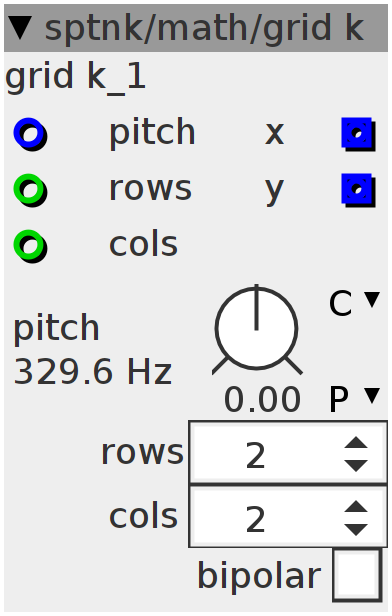grid k
Generates a 2d grid, for further lissajous applications. K-rate .
Inlets
frac32 pitch of the oscillator
int32 number of rows, overrides the parameter
int32 number of columns, overrides the parameter
Outlets
frac32 x coordinate
frac32 y coordinate
Parameters
frac32.s.map.pitch pitch of the oscillator
int32 number of rows
int32 number of columns
bool32.tgl bipolar output if checked (rows and columns spanning from -64 to 64 instead of 0 to 64)
uint32_t phase = 0;
uint32_t phase_old = 0;
int i = 0;// begin of k-rate code
int rows = param_rows;
int cols = param_cols;
if (inlet_rows > 1 && inlet_rows < 65)
rows = inlet_rows;
if (inlet_cols > 1 && inlet_cols < 65)
cols = inlet_cols;
int rpc = rows + cols;
uint32_t rowspacing = (1 << 27) / (rows - 1);
uint32_t colspacing = (1 << 27) / (cols - 1);
uint32_t freq = MTOFEXTENDED((inlet_pitch + param_pitch), freq);
freq *= rpc;
// begin of k-rate code that you can actually move to s-rate
phase_old = phase;
phase += freq;
// i want to draw row1 -> row2 -> row3 -> .. -> row R -> col 1 -> col2 -> col3
// -> .. -> col N
int i_rows = i - rows;
int32_t x;
int32_t y;
if (i < rows) // draw rows
{
x = phase >> 5;
y = i * rowspacing;
} else // draw columns
{
x = i_rows * colspacing;
y = phase >> 5;
}
if (phase <= phase_old)
i++;
if (i >= rpc)
i = 0;
if (param_bipolar) {
outlet_x = (x << 1) - (1 << 27);
outlet_y = (y << 1) - (1 << 27);
} else {
outlet_x = x;
outlet_y = y;
}